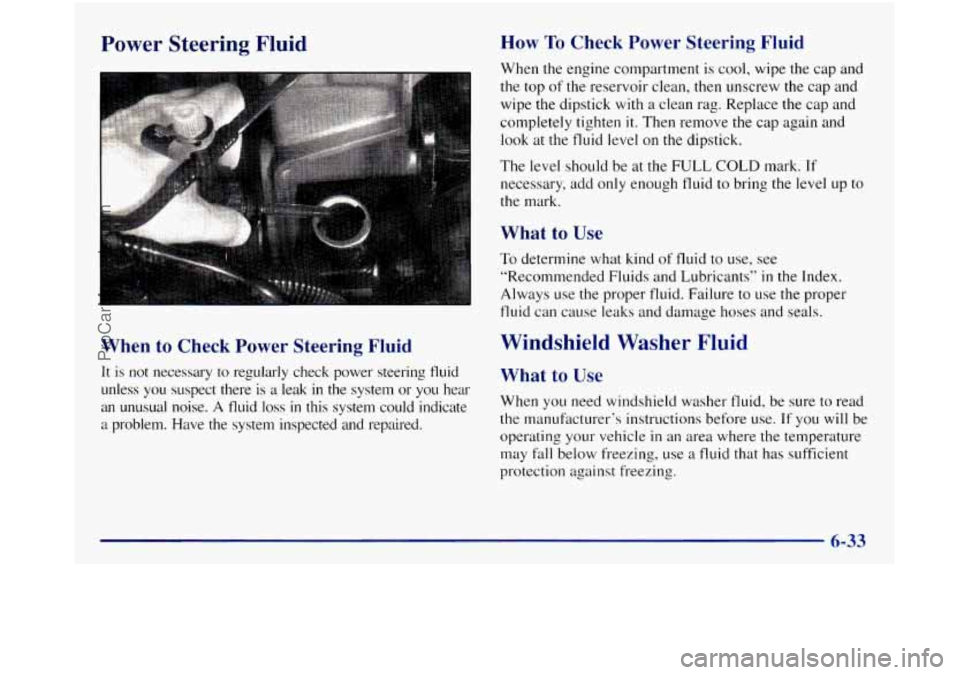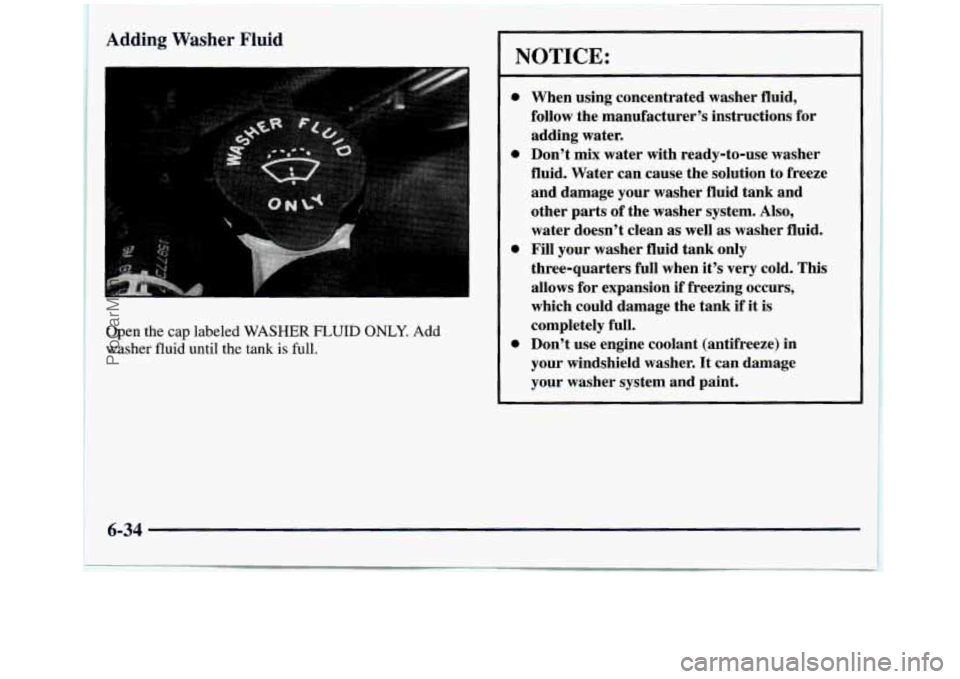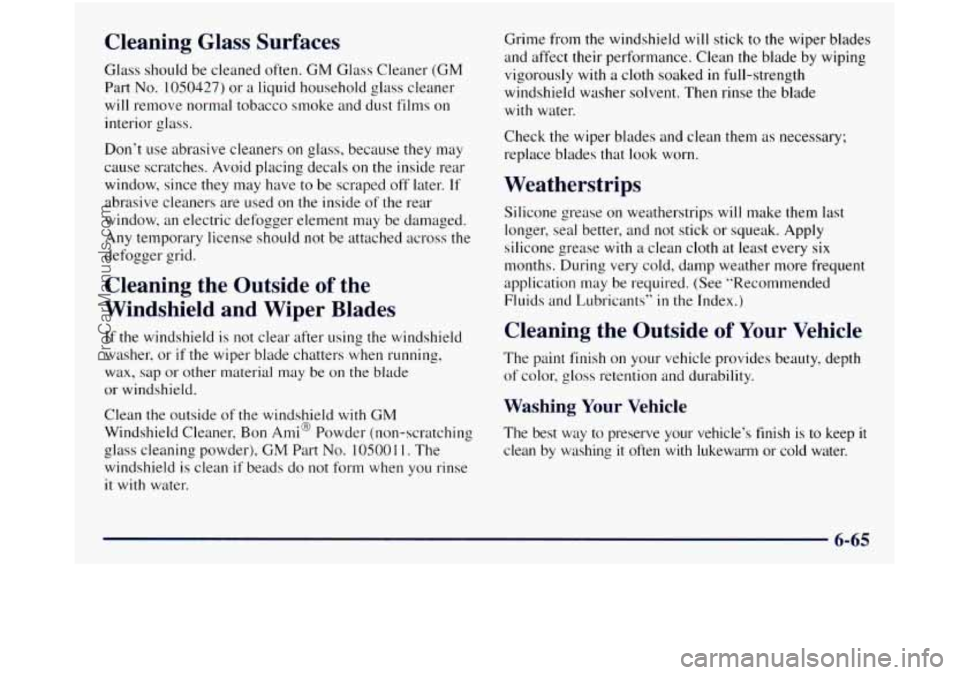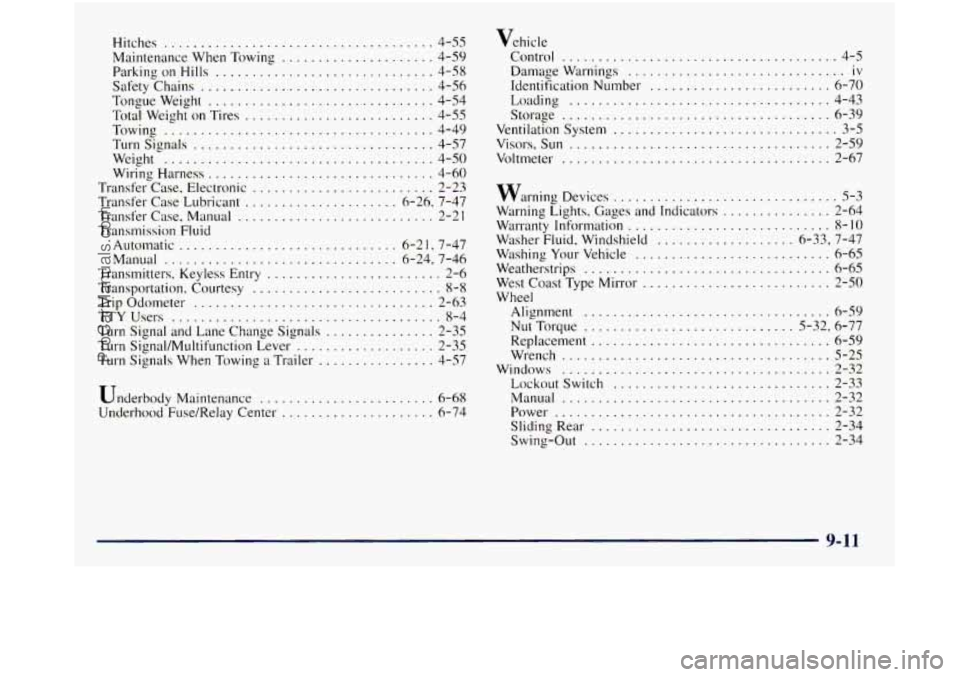1998 GMC SIERRA washer fluid
[x] Cancel search: washer fluidPage 302 of 452

“VORTEC” 7400 Engine
A. Battery
B. Coolant Recovery Tank
C. Air Cleaner
D. Radiator Cap
E. Air Filter Restriction Indicator
F. Engine Oil Dipstick
G. Automatic Transmission L. Clutch Fluid Reservoir
Dipstick (If Equipped)
(If Equipped)
H. Engine Oil Fill M. Windshield Washer
I. Fan Fluid Reservoir
J. Power Steering Fluid Reservoir N. Fusemelay Center
K. Brake Fluid Reservoir
ProCarManuals.com
Page 323 of 452

Power Steering Fluid
When to Check Power Steering Fluid
It is not necessary to regularly check power steering fluid
unless you suspect there is
a leak in the system or you hear
an unusual noise.
A fluid loss in this system could indicate
a problem. Have the system inspected and repaired.
How To Check Power Steering Fluid
When the engine compartment is cool, wipe the cap and
the top of the reservoir clean, then unscrew the cap and
wipe the dipstick
with a clean rag. Replace the cap and
completely tighten it. Then remove the cap again and
look at the fluid level on the dipstick.
The level should be at the FULL
COLD mark. If
necessary, add only enough fluid
to bring the level up to
the mark.
What to Use
To determine what kind of fluid to use, see
“Recommended Fluids and Lubricants”
in the Index.
Always use the proper fluid. Failure to use the proper
fluid can cause leaks and damage hoses and seals.
Windshield Washer Fluid
What to Use
When YOLI need windshield washer fluid, be sure to read
the manufacturer‘s instructions before use.
If you will be
operating your vehicle
in an area where the temperature
may
fdll below freezing, use a fluid that has sufficient
protection against freezing.
6-33
ProCarManuals.com
Page 324 of 452

Adding Washer Fluid
Open the cap labeled WASHER FLUID ONLY. Add
washer fluid until the tank is full.
1
NOTICE:
0
0
0
0
When using concentrated washer fluid,
follow the manufacturer’s instructions for
adding water.
Don’t mix water with ready-to-use washer
fluid. Water can cause the solution to freeze
and damage your washer fluid tank and
other parts of the washer system. Also,
water doesn’t clean as well as washer fluid.
Fill your washer fluid tank only
three-quarters full when it’s very cold. This
allows for expansion if freezing occurs,
which could damage the tank if it is
completely full.
Don’t use engine coolant (antifreeze) in
your windshield washer. It can damage
your washer system and paint.
6-34
ProCarManuals.com
Page 355 of 452

Cleaning Glass Surfaces
Glass should be cleaned often. GM Glass Cleaner (GM
Part
No. 1050427) or a liquid household glass cleaner
will remove normal tobacco smoke and dust films on
interior glass.
Don’t use abrasive cleaners
on glass, because they may
cause scratches. Avoid placing decals
on the inside rear
window, since they may have to be scraped off 1ate.r.
If
abrasive cleaners are used on the inside of the rear
window, an electric defogger element may be damaged.
Any temporary license should
not be attached across the
defogger grid.
Cleaning the Outside of the
Windshield and Wiper Blades
If the windshield is not clear after using the windshield
washer. or
if the wiper blade chatters when running,
wax, sap
or other material may be on the blade
or windshield.
Clean the outside of the windshield with GM
Windshield Cleaner, Bon Ami@ Powder (non-scratching
windshield is clean
if beads do not form when you rinse
it with water.
= olass cleaning powder), GM Part No. 10500 I 1. The Grime from
the windshield will stick to the wiper blades
and affect their performance. Clean the blade by wiping
vigorously with
a cloth soaked in full-strength
windshield washer solvent. Then rinse the blade
with water.
Check the wiper blades
and clean them as necessary;
replace blades that
look worn.
Weatherstrips
Silicone grease on weatherstrips will make them last
longer, seal better, and not stick or squeak. Apply
silicone grease with a clean cloth at least every six
months. During very cold, damp weather more frequent
application may be required. (See “Recommended
Fluids and Lubricants”
in the Index.)
Cleaning the Outside of Your Vehicle
The paint finish on your vehicle provides beauty, depth
of color, gloss retention and durability.
Washing Your Vehicle
The best way to preserve your vehicle’s finish is to keep it
clean by washing it often with lukewarm or cold water.
6-65
ProCarManuals.com
Page 410 of 452

Part B: Owner Checks and Services
Listed below are owner checks and services which
should be performed at the intervals specified
to help
ensure
the safety, dependability and emission control
performance
of your vehicle.
Be sure any necessary repairs are completed at once.
Whenever
any fluids or lubricants are added to your
vehicle, make sure they are the proper ones.
as shown in
Part D.
At the First 100, 1,000 and 6,000 Miles
(160,1600 and 10 000 km)
For vehicles with dual wheels, check dual wheel nut
torque. For proper torque, see “Wheel Nut Torque” in
the Index.
At Each Fue-
Engine Oil Level Check
Check the engine oil level and add the proper oil if
necessary. See “Engine Oil” in the Index for
further details.
Engine Coolant Level Check
Check the engine coolant level and add DEX-COOL@
coolant mixture if necessary. See “Engine Coolant” in
the Index for further details.
Windshield Washer Fluid Level Check
Check the windshield washer fluid level in the
windshield washer tank and add the proper fluid
if
necessary. See ”Windshield Washer Fluid” in the Index
for ElIrther details.
At Least Once a Month
Tire Inflation Check
Make sure tires are inflated to the correct pressures.
See “Tires”
in the Index for further details.
Cassette Deck Service
Clean cassette deck. Cleaning should be done every
50 hours of tape play. See “Audio Systems“ in the
Index for further details.
ProCarManuals.com
Page 417 of 452

USAGE
Automatic
Transmission
Key Lock
Cylinders
Linkage
I
Chassis Lubrication
Front Wheel
Bearings
Differential,
Front and Rear
Axle
FLUIDLUBRICANT
DEXRON@-I11 Automatic
Transmission Fluid.
Multi-Pur ose Lubricant,
Superlube
L (GM Part
No. 1234624 1 or equivalent).
Lubriplate@ Lubricant Aerosol
(GM Part No. 12346293 or
equivalent) or lubricant meeting
requirements
of NLGI # 2
Category LB or GC-LB.
Chassis Lubricant (GM Part
No. 12377985 or equivalent) or
lubricant meeting requirements of
NLGI # 2, Category LB or
GC-LB.
Wheel Bearing Lubricant meeting
requirements
of NLGI # 2,
Category GC or GC-LB (GM Part
No. 1 OS 1344 or equivalent).
Axle Lubricant (GM Part
GL-5 Gear Lubricant.
NO. 1052271) or SAE 8OW-90
USAGE
Differential, C3
(HD3500)
Trucks With
Dana Rear Axle
Transfer Case
Windshield
Washer Solvent
Front Axle
Propshaft Spline,
Rear Driveline
Center Splines
and Universal
Joints
One-Piece
Propshaft Spline
(Two-Wheel
Drive with Auto.
Trans
.)
FLUIDLUBRICANT
SAE 75W- 140 Synthetic Gear
Lubricant (GM Part
No. 12346 140) or equivalent.
DEXRON@-111 Automatic
Transmission Fluid.
GM Optikleen@ Washer Solvent
(GM Part
No. 105 15 15)
or equivalent.
Chassis Lubricant (GM Part
No. 12377985 or equivalent) or
lubricant meeting requirements
of
NLGI # 2, Category LE or
GC-LB.
Spline Lubricant, Special
Lubricant (GM Part
No. 12345879) or lubricant
meeting requirements of
GM 998530.
7-47
ProCarManuals.com
Page 445 of 452

Hitches ..................................... 4-55
Maintenance When Towing
..................... 4-59
Parking on Hills
.............................. 4-58
Safety Chains
................................ 4-56
Tongueweight
............................... 4-54
Total Weight on Tires
.......................... 4-55
Towing
..................................... 4-49
Turn Signals ................................. 4-57
Weight
..................................... 4-50
Wiring Harness
............................... 4-60
Transfer Case. Electronic
......................... 2-23
Transfer Case Lubricant ..................... 6-26 . 7-47
Transfer Case. Manual
........................... 2-2 1
Transmission Fluid
Automatic
.............................. 6-2 1.7-47
Manual
................................ 6-24. 7-46
Transmitters. Keyless Entry
........................ 2-6
Transportation
. Courtesy .......................... 8-8
Trip Odometer ................................. 2-63
TTYUsers
..................................... 8-4
Turn Signal and Lane Change Signals
............... 2-35
Turn SignaVMultifunction Lever
................... 2-35
Turn Signals When Towing a Trailer
................ 4-57
Underbody Maintenance
........................ 6-68
Underllood-Fuse/Relay Center
..................... 6-74 Vehicle
Control
...................................... 4-5
Damage Warnings
.............................. iv
Identification Number ......................... 6-70
Loading
.................................... 4-43
Storage
..................................... 6-39
Ventilation System
............................... 3-5
Visors. Sun .................................... 2-59
Voltmeter
..................................... 2-67
warning Devices
............................... 5-3
Wxranty Information
............................ 8- IO
Washer Fluid. Windshield ................... 6.33. 7-47
Washing
Your Vehicle ........................... 6-65
Weatherstrips
.................................. 6-65
West Coast Type Mirror
.......................... 2-50
Wheel Warning
Lights
. Gages and Indicators ............... 2-64
Alignment
.................................. 6-59
Nut Torque ............................. 5-32. 6-77
Replacement
................................. 6-59
Wrench
..................................... 5-25
Windows
..................................... 2-32
Lockout Switch
.............................. 2-33
Manual
..................................... 2-32
Power
...................................... 2-32
Sliding Rear
................................. 2-34
Swing-Out
.................................. 2-34
9-11
ProCarManuals.com